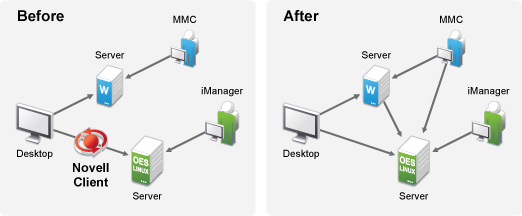3.2 Working With Windows Systems Without Novell Client
DSfW allows Microsoft Windows users to work in a pure Windows desktop environment and still take advantage of some OES back-end services and technology, without the need for a Novell Client on the desktop.
Administrators can either use Novell iManager or Microsoft Management Console (MMC) to administer users and groups. Network administrators manage file systems using the native tools of each server, as well as centrally administer Samba shares on OES Linux/DSfW servers using iManager. Administrators can use MMC to create cross-forest trusts between DSfW domains and Active Directory domains.
When deployed in an environment that also supports NetWare Core Protocol (NCP), DSfW supports cross-protocol locking. Whether customers decide to use only Windows clients, NCP clients, or a combination of both, access rights for files is enforced by the Novell Storage Services (NSS) file system. Novell Client does not need to be installed and managed as an extra software on the desktop. This helps in streamlining user experiences in terms of login to the directory and single login facility to both Active Directory applications and eDirectory services.
Figure 3-3 Accessing applications without Novell Client

IMPORTANT:Do not install the Novell Client for Windows on a workstation for which you plan to provide native Windows access to DSfW servers. Novell Client access and native Windows access to DSfW servers do not work well together on the same workstation. But if you already have Novell Client installed on your workstation, we recommend that you follow the instructions in Joining a Workstation that Has Novell Client Installed